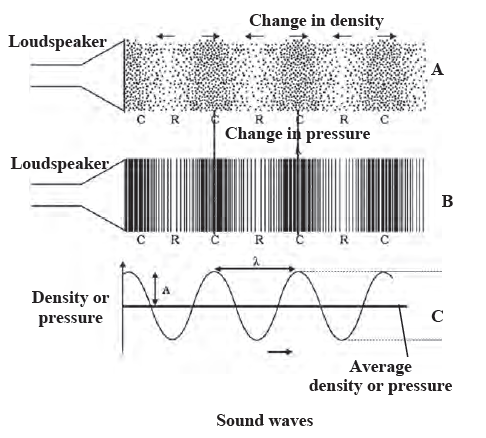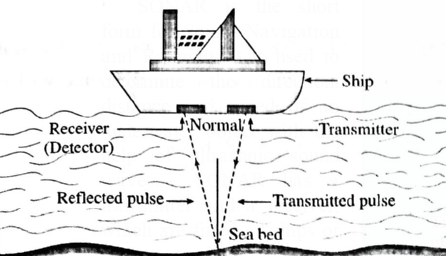Study of Sound
Maharashtra Board-Class 9-Science & Technology-Chapter-12
Notes
|
Topics to be learn :
|
Sound : Sound is a form of energy which creates the sensation of hearing in our ears.
- This energy is in the form of waves.
- A medium is necessary for the propagation of sound waves.
- Sound Waves give rise to a chain of compression (place of higher density) and rarefaction (place of lower density) in the medium.
Production of sound : Sound is produced due to vibrations of an object such as a stretched membrane or a string under tension. It propagates in the form of waves. It requires a medium (substance in the form of solid/liquid/ gas) for propagation, i.e., it cannot travel through a vacuum. Sound propagates in the form of longitudinal waves. As sound propagates through a medium, there is a change in the density and pressure of the medium. A sound wave can be shown in the form of a graph. At any moment during the propagation of a sound wave we would find alternate bands of compression and rarefaction of the medium i.e. bands of greater and lesser density. Figure A shows the changes in density while figure B shows the changes in pressure. The changes in density or pressure are shown in the form of a graph in figure C Here, λ : Wavelength, A : amplitude (maximum pressure or maximum density). T: time taken for one oscillation of pressure or density at a point in the medium. The frequency (ν) : is the number of oscillations per unit time. ν = 1/ T. ν determines the pitch and A determines the loudness of sound. '

Waves : A wave is a disturbance moving through a medium when the particles of the medium set neighbouring particles in motion.
- A wave motion is a mode of transmission of energy through the medium.
- A wave in which the particles of the medium oscillate (vibrate) about their mean positions in a direction perpendicular to the direction of wave propagation is called a transverse wave.
- A wave in which the particles of the medium oscillate (vibrate) about their mean positions in a direction parallel to the direction of wave propagation is called a longitudinal wave.
- The particles do not move from one part to another part of the medium.
Velocity of sound : From the above activity you can see that you hear the sound through the iron pipe much before you hear it coming through air. This shows that sound travels faster in iron than in air.
Characteristics of sound waves : The distance between consecutive compressions or consecutive rarefactions is called wavelength v = \(\frac{λ}{T}\) = νλ
| The Italian physicists Borelli and viviani, in the 1660s, first calculated the speed of sound. They measured the time between seeing the flash of a gun and hearing its sound from a long distance. Their value of 350 m/ s is very close to the value of 346 m/ s which is accepted today. |
Velocity of sound in a gaseous medium: The velocity of sound in a gaseous medium depends on the physical conditions i.e. the temperature, density of the gas and its molecular weight.
The speed of sound in a gas is
v = \(\sqrt{\frac{γp}{ρ}}=\sqrt{\frac{γRT}{M}}\)
Temperature (T): The velocity of sound is directly proportional to the square root of the temperature of the medium. This means that increasing the temperature four times doubles the velocity. v ∝ \(\sqrt{T}\)
Density (ρ): The velocity of sound is inversely proportional to the square root of density. v ∝ \(\sqrt{\frac 1ρ}\)
Thus, increasing the density four times, reduces the velocity to half its value.
Molecular weight (M): The velocity sound is inversely proportional to the square root of molecular weight of the gas. Thus, increasing the molecular weight four times, reduces the velocity to half its value. v ∝ \(\sqrt{\frac 1M}\)
Range of hearing in humans : The range of hearing in humans is from 20 Hz to 20000 Hz.
| Q. How are the frequencies of notes sa, re, ga, ma, pa, dha, ni related to each other?
Standard tuning: sa-440 Hz, re - about 494 Hz, ga - about 554 Hz, ma - about 587 Hz, pa - about 659 Hz, dha - about 740 Hz, ni - about 831 Hz, sa -(octave) 880 Hz. Frequency ratio : re : sa about 1.12, ga : re about 1.12, sa (octave) : sa = 2.
Q. What is the main difference between the frequencies of the voice of a man and that of a woman?
The voice of a man has higher pitch (higher frequency) than that of a woman.
|
Infrasound and ultrasound: The sound of frequency less than 20 Hz is called infrasound and that of frequency more than 20000 Hz is called ultrasound. We cannot hear infrasound and ultrasound.
Uses of Ultrasounds :
Reflection of sound : Sound waves follow the same laws of reflection as followed by light waves. The directions in which sound is incident and reflected make equal angles with the normal to the reflecting surface at the point of incidence and the three are in the same plane.
Echo : Repetition of original sound due to reflection from a surface is called echo.
The sensation of sound persists in our brain for about 0.1 second. The speed of sound in air at 22 °C is 344 m/s. Hence, for hearing distinct echo, the minimum distance of the reflecting surface from the source of sound must be 17.2 m in air at 22 °C.
Reverberation :The persistence of sound due to repeated reflection of sound in a big hall or an auditorium is called reverberation.
In reverberation, the intensity of sound and the time interval between the successive arrivals of the same sound go on decreasing with time. Excessive reverberation is not desirable as the speech of a speaker or the pitch of music cannot be heard clearly due to the mixing of reflected waves and direct waves produced after the production of earlier waves. To avoid these problems, reverberation should be reduced/controlled. For this the roof and walls of the auditorium are covered with sound absorbent materials such as compressed fibre boards, rough plaster or curtains. Even the material of the seat is chosen such that it absorbs sound waves to the desired extent.
SONAR: Sound navigation and ranging (SONAR) refers to determination of the distance and location of underwater objects using ultrasonic waves.

Sonography : In this case, ultrasounds (ultrasonic Waves) are used to produce images of internal organs of the human body.
The human ear : The human ear converts pressure variations in air with audible frequencies into electrical signals that travel to the brain, via the auditory nerve. Hence, we can hear sound.
Outer ear or Pinna The outer ear collects the sound waves and passes them through a tube to a cavity in the middle ear. Middle ear There is a thin membrane in the cavity of the middle ear called the eardrum. When a compression in a sound wave reaches the eardrum, the pressure outside it increases and it gets pushed inwards. The opposite happens when a rarefaction reaches there. The pressure outside decreases and the membrane gets pulled outwards. Thus, sound waves cause vibrations of the membrane. Inner ear The auditory nerve connects the inner ear to the brain. The inner ear has a structure resembling the shell of a snail. It is called the cochlea. The cochlea receives the vibrations coming from the membrane and converts them into electrical signals which are sent to the brain through the nerve. The brain analyses these signals.
| The ear is an important sensory organ. Sticks or other pointed objects should never be inserted into the ear for cleaning it. Also, one should not hear very loud music using earphones. It may cause grave injury to the eardrum. |
Useful links :
| Main Page : - Maharashtra Board Class 9th Science & Technology - All chapters notes, solutions, videos, test, pdf.
Previous Chapter : Chapter 11: Reflection of Light - online Notes Next Chapter : Chapter 13: Carbon :An Important Element - online Notes |
Var good content in wedsite